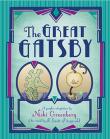'In homage to F. Scott Fitzgerald's jazz age classic, this acclaimed graphic adaptation brings to life the glitter, the melancholy and the grand and crumpled dreams of Fitzgerald's unforgettable characters.
'Daisy, Nick, Tom, Jordan and Gatsby himself are rendered true to Fitzgerald's original characterisation, with a difference: they are not human. Inhabiting the authentic setting of 1920s New York, they join a throng of fantastical creatures to play out the drama, the wry humour and the tragedy of the novel.
'The book is presented in the form of an old photograph album, with the snapshots forming the "frames" of the story. In this way, the reader is invited into the private world of the characters, while sharing the sense of nostalgia and loss that pervades the novel.'
Source: Publisher's blurb.
 6832443616546190833.jpg
6832443616546190833.jpg
 The Great Gatsby : A Graphic Adaptation of the Novel by F. Scott Fitzgerald
single work
young adult
The Great Gatsby : A Graphic Adaptation of the Novel by F. Scott Fitzgerald
single work
young adult


